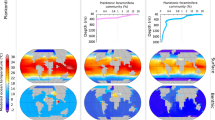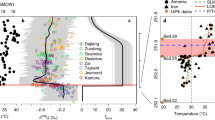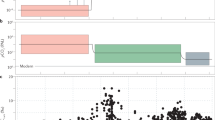Abstract
The biological pump—the transfer of atmospheric carbon dioxide to the ocean interior and marine sediments as organic carbon—plays a critical role in regulating the long-term carbon cycle, atmospheric composition and climate. Despite its centrality in the Earth system, the response of the biological pump to biotic innovation and climatic fluctuations through most stages of Earth’s history has been largely conjectural. Here we use a mechanistic model of the biological carbon pump to revisit the factors controlling the transfer efficiency of carbon from surface waters to the ocean interior and marine sediments. We demonstrate that a shift from bacterioplankton-dominated to more eukaryote-rich ecosystems is unlikely to have considerably impacted the efficiency of Earth’s biological pump. In contrast, the evolution of large zooplankton capable of vertical movement in the water column would have enhanced carbon transfer into the ocean interior. However, the impact of zooplankton on the biological carbon pump is still relatively minor when compared with environmental drivers. In particular, increased ocean temperatures and greater atmospheric oxygen abundance lead to notable decreases in global organic carbon transfer efficiency. Taken together, our results call into question causative links between algal diversification and planetary oxygenation and suggest that climate perturbations in Earth’s history have played an important and underappreciated role in driving both carbon sequestration in the ocean interior and Earth surface oxygenation.
This is a preview of subscription content, access via your institution
Access options
Access Nature and 54 other Nature Portfolio journals
Get Nature+, our best-value online-access subscription
$29.99 / 30 days
cancel any time
Subscribe to this journal
Receive 12 print issues and online access
$259.00 per year
only $21.58 per issue
Buy this article
- Purchase on Springer Link
- Instant access to full article PDF
Prices may be subject to local taxes which are calculated during checkout




Similar content being viewed by others
Data availability
We have chosen not to deposit the data at this time but declare that data supporting the findings of this study are available within this article and its Supplementary Information, and all additional data are available from the corresponding author on request.
Code availability
All additional computer codes are available from the corresponding author on request.
References
Gwizd, S. J. Paleoceanography of the Eastern Equatorial Pacific: Insights from a new Carnegie Platform Stratigraphic Record. MS thesis, Univ. California, Santa Barbara (2015).
Boyd, P. W. & Trull, T. W. Understanding the export of biogenic particles in oceanic waters: is there consensus? Prog. Oceanogr. 72, 276–312 (2007).
Volk, T. & Hoffert, M. I. in The Carbon Cycle and Atmospheric CO2: Natural Variations Archean to Present Vol. 32 (eds Sundquist, E. T. & Broecker, W. S.) 99–110 (American Geophysical Union, 1985).
Ducklow, H. W., Steinberg, D. K. & Buesseler, K. O. Upper ocean carbon export and the biological pump. Oceanography 14, 50–58 (2001).
Fowler, S. W. & Knauer, G. A. Role of large particles in the transport of elements and organic compounds through the oceanic water column. Prog. Oceanogr. 16, 147–194 (1986).
Alldredge, A. L. & Silver, M. W. Characteristics, dynamics and significance of marine snow. Prog. Oceanogr. https://doi.org/10.1016/0079-6611(88)90053-5 (1988).
Lyons, T. W., Reinhard, C. T. & Planavsky, N. J. The rise of oxygen in Earth’s early ocean and atmosphere. Nature 506, 307–315 (2014).
Lenton, T. M., Boyle, R. A., Poulton, S. W., Shields-Zhou, G. A. & Butterfield, N. J. Co-evolution of eukaryotes and ocean oxygenation in the Neoproterozoic era. Nat. Geosci. 7, 257–265 (2014).
Butterfield, N. J. Plankton ecology and the Proterozoic–Phanerozoic transition. Paleobiology 23, 247–262 (1997).
Knoll, A. H. & Nowak, M. A. The timetable of evolution. Sci. Adv. 3, e1603076 (2017).
Butterfield, N. J. Oxygen, animals and oceanic ventilation: an alternative view. Geobiology 7, 1–7 (2009).
Bartley, J. K. & Kah, L. C. Marine carbon reservoir, Corg–Ccarb coupling, and the evolution of the Proterozoic carbon cycle. Geology 32, 129–132 (2004).
Zhang, S. et al. Sufficient oxygen for animal respiration 1,400 million years ago. Proc. Natl Acad. Sci. USA 113, 1731–1736 (2016).
Isson, T. T. et al. Tracking the rise of eukaryotes to ecological dominance with zinc isotopes. Geobiology 16, 341–352 (2018).
Love, G. D. et al. Fossil steroids record the appearance of Demospongiae during the Cryogenian period. Nature https://doi.org/10.1038/nature07673 (2009).
Knoll, A. H. & Sperling, E. A. Oxygen and animals in Earth history. Proc. Natl Acad. Sci. USA https://doi.org/10.1073/pnas.1401745111 (2014).
Planavsky, N. J. et al. No evidence for high atmospheric oxygen levels 1,400 million years ago. Proc. Natl Acad. Sci. 113, E2550–E2551 (2016).
Vannier, J. & Chen, J. Y. The early Cambrian colonization of pelagic niches exemplified by Isoxys (Arthropoda). Lethaia 33, 295–311 (2000).
Knoll, A. H., Javaux, E. J., Hewitt, D. & Cohen, P. Eukaryotic organisms in Proterozoic oceans. Philos. Trans R. Soc. Lond. B 361, 1023–1038 (2006).
Falkowski, P. G. in Encyclopedia of Biodiversity 2nd edn, 552–564 (Elsevier, 2013).
Logan, B. E. & Wilkinson, D. B. Fractal geometry of marine snow and other biological aggregates. Limnol. Oceanogr. 35, 130–136 (1990).
Berry, W. B. N., Wilde, P. & Quinby-Hunt, M. S. Paleozoic (Cambrian through Devonian) anoxitropic biotopes. Palaeogeogr. Palaeoclimatol. Palaeoecol. 74, 3–13 (1989).
Butterfield, N. J. Oxygen, animals and aquatic bioturbation: an updated account. Geobiology 16, 3–16 (2018).
Polyakova, Y. I. Late Cenozoic evolution of northern Eurasian marginal seas based on the diatom record. Polarforschung 69, 211–220 (1999).
Harwood, D. M., Nikolaev, V. A. & Winter, D. M. Cretaceous records of diatom evolution, radiation, and expansion. Paleontol. Soc. Pap. 13, 33–59 (2007).
Lenton, T. M. & Daines, S. J. The effects of marine eukaryote evolution on phosphorus, carbon and oxygen cycling across the Proterozoic–Phanerozoic transition. Emerg. Top. Life Sci. https://doi.org/10.1042/ETLS20170156 (2018).
Tziperman, E., Halevy, I., Johnston, D. T., Knoll, A. H. & Schrag, D. P. Biologically induced initiation of Neoproterozoic snowball-Earth events. Proc. Natl Acad. Sci. USA https://doi.org/10.1073/pnas.1016361108 (2011).
Jokulsdottir, T. & Archer, D. A stochastic, Lagrangian model of sinking biogenic aggregates in the ocean (SLAMS 1.0): model formulation, validation and sensitivity. Geosci. Model Dev. 9, 1455–1476 (2016).
Dzierzbicka-Głowacka, L. Encounter rates in zooplankton. Pol. J. Environ. Stud. 15, 243–257 (2006).
Archibald, K. M., Siegel, D. A. & Doney, S. C. Modeling the impact of zooplankton diel vertical migration on the carbon export flux of the biological pump. Global Biogeochem. Cycles 33, 181–199 (2019).
Middelburg, J. J. A simple rate model for organic matter decomposition in marine sediments. Geochim. Cosmochim. Acta 53, 1577–1581 (1989).
Katsev, S. & Crowe, S. A. Organic carbon burial efficiencies in sediments: the power law of mineralization revisited. Geology 43, 607–610 (2015).
Quinlan, A. V. The thermal sensitivity of Michaelis–Menten kinetics as a function of substrate concentration. J. Franklin Inst. 310, 325–342 (1980).
Quinlan, A. V. The thermal sensitivity of generic Michaelis–Menten processes without catalyst denaturation or inhibition. J. Therm. Biol. 6, 103–114 (1981).
Segschneider, J. & Bendtsen, J. Temperature-dependent remineralization in a warming ocean increases surface pCO2 through changes in marine ecosystem composition. Global Biogeochem. Cycles 27, 1214–1225 (2013).
John, E. H., Wilson, J. D., Pearson, P. N. & Ridgwell, A. Temperature-dependent remineralization and carbon cycling in the warm Eocene oceans. Palaeogeogr. Palaeoclimatol. Palaeoecol. 413, 158–166 (2014).
Iversen, M. H., Ploug, H. & Wegener, A. Ballast minerals and the sinking carbon flux in the ocean: carbon-specific respiration rates and sinking velocity of marine snow aggregates. Biogeosciences 7, 2613–2624 (2010).
Klaas, C. & Archer, D. E. Association of sinking organic matter with various types of mineral ballast in the deep sea: implications for the rain ratio. Global Biogeochem. Cycles 16, 1116 (2002).
Bianchi, D., Stock, C., Galbraith, E. D. & Sarmiento, J. L. Diel vertical migration: ecological controls and impacts on the biological pump in a one-dimensional ocean model. Global Biogeochem. Cycles 27, 478–491 (2013).
Kunze, E. Biologically generated mixing in the ocean. Annu. Rev. Mar. Sci. 11, 215–226 (2019).
Katija, K. Biogenic inputs to ocean mixing. J. Exp. Biol. 215, 1040–1049 (2012).
Kunze, E. Fluid mixing by swimming organisms in the low-Reynolds-number limit. J. Mar. Res. 69, 591–601 (2011).
Arnosti, C., Jørgensen, B. B., Sagemann, J. & Thamdrup, B. Temperature dependence of microbial degradation of organic matter in marine sediments: polysaccharide hydrolysis, oxygen consumption, and sulfate reduction. Mar. Ecol. Prog. Ser. 165, 59–70 (1998).
Marsay, C. M. et al. Attenuation of sinking particulate organic carbon flux through the mesopelagic ocean. Proc. Natl Acad. Sci. USA 112, 1089–1094 (2015).
Laakso, T. A. & Schrag, D. P. A small marine biosphere in the Proterozoic. Geobiology 17, 161–171 (2019).
Dore, J. E., Lukas, R., Sadler, D. W., Church, M. J. & Karl, D. M. Physical and biogeochemical modulation of ocean acidification in the central North Pacific. Proc. Natl Acad. Sci. USA 106, 12235–12240 (2009).
McDonnell, A. M. P. & Buesseler, K. O. Variability in the average sinking velocity of marine particles. Limnol. Oceanogr. 55, 2085–2096 (2010).
Alonso-Gonz lez, I. J. et al. Role of slowly settling particles in the ocean carbon cycle. Geophys. Res. Lett. 37, L13608 (2010).
Dunne, J. P., Sarmiento, J. L. & Gnanadesikan, A. A synthesis of global particle export from the surface ocean and cycling through the ocean interior and on the seafloor. Global Biogeochem. Cycles 21, GB4006 (2007).
Canfield, D. E., Rosing, M. T. & Bjerrum, C. Early anaerobic metabolisms. Philos. Trans R. Soc. Lond. B 361, 1819–1834 (2006).
Martin, J. H., Knauer, G. A., Karl, D. M. & Broenkow, W. W. VERTEX: carbon cycling in the northeast Pacific. Deep Sea Res. 34, 267–285 (1987).
Kahl, L., Vardi, A. & Schofield, O. Effects of phytoplankton physiology on export flux. Mar. Ecol. Prog. Ser. 354, 3–19 (2008).
Dam, H. G. & Drapeau, D. T. Coagulation efficiency, organic-matter glues and the dynamics of particles during a phytoplankton bloom in a mesocosm study. Deep Sea Res. 2 42, 111–123 (1995).
Passow, U. & Alldredge, A. L. Distribution, size and bacterial colonization of transparent exopolymer particles (TEP) in the ocean. Mar. Ecol. Prog. Ser. 113, 185–198 (1994).
Engel, A. The role of transparent exopolymer particles (TEP) in the increase in apparent particle stickiness (α) during the decline of a diatom bloom. J. Plankton Res. 22, 485–497 (2000).
Alldredge, A. L. & Gotschalk, C. In situ settling behavior of marine snow. Limnol. Oceanogr. 33, 339–351 (1988).
Briggs, N., Dall'Olmo, G. & Claustre, H. Major role of particle fragmentation in regulating biological sequestration of CO2 by the oceans. Science 367, 791–793 (2020).
Alldredge, A. L., Granata, T. C., Gotschalk, C. C. & Dickey, T. D. The physical strength of marine snow and its implications for particle disaggregation in the ocean. Limnol. Oceanogr. 35, 1415–1428 (1990).
Dilling, L. & Alldredge, A. L. Fragmentation of marine snow by swimming macrozooplankton: a new process impacting carbon cycling in the sea. Deep Sea Res. 1 47, 1227–1245 (2000).
Iversen, M. H. et al. Sinkers or floaters? Contribution from salp pellets to the export flux during a large bloom event in the Southern Ocean. Deep Sea Res. 2 138, 116–125 (2017).
Cohen, J. H. & Forward R. B. Jr in Oceanography and Marine Biology: An Annual Review Vol. 47 (eds Gibson, R. N. et al.) 77–110 (CRC Press, 2009).
Bianchi, D., Galbraith, E. D., Carozza, D. A., Mislan, K. A. S. & Stock, C. A. Intensification of open-ocean oxygen depletion by vertically migrating animals. Nat. Geosci. 6, 545–548 (2013).
Bollens, S. M., Rollwagen-Bollens, G., Quenette, J. A. & Bochdansky, A. B. Cascading migrations and implications for vertical fluxes in pelagic ecosystems. J. Plankton Res. 33, 349–355 (2011).
Acknowledgements
C.T.R. and N.J.P. acknowledge funding from the National Aeronautics and Space Administration Astrobiology Institute and the National Science Foundation.
Author information
Authors and Affiliations
Contributions
All authors designed the research. M.F. developed the model and performed model simulations and sensitivity analyses. All authors interpreted model results and wrote the paper.
Corresponding author
Ethics declarations
Competing interests
The authors declare no competing interests.
Additional information
Peer review information Primary Handling Editor: Rebecca Neely.
Publisher’s note Springer Nature remains neutral with regard to jurisdictional claims in published maps and institutional affiliations.
Supplementary information
Supplementary Information
Supplementary text and Figs. 1–13.
Rights and permissions
About this article
Cite this article
Fakhraee, M., Planavsky, N.J. & Reinhard, C.T. The role of environmental factors in the long-term evolution of the marine biological pump. Nat. Geosci. 13, 812–816 (2020). https://doi.org/10.1038/s41561-020-00660-6
Received:
Accepted:
Published:
Issue Date:
DOI: https://doi.org/10.1038/s41561-020-00660-6
This article is cited by
-
What the geological past can tell us about the future of the ocean’s twilight zone
Nature Communications (2023)



